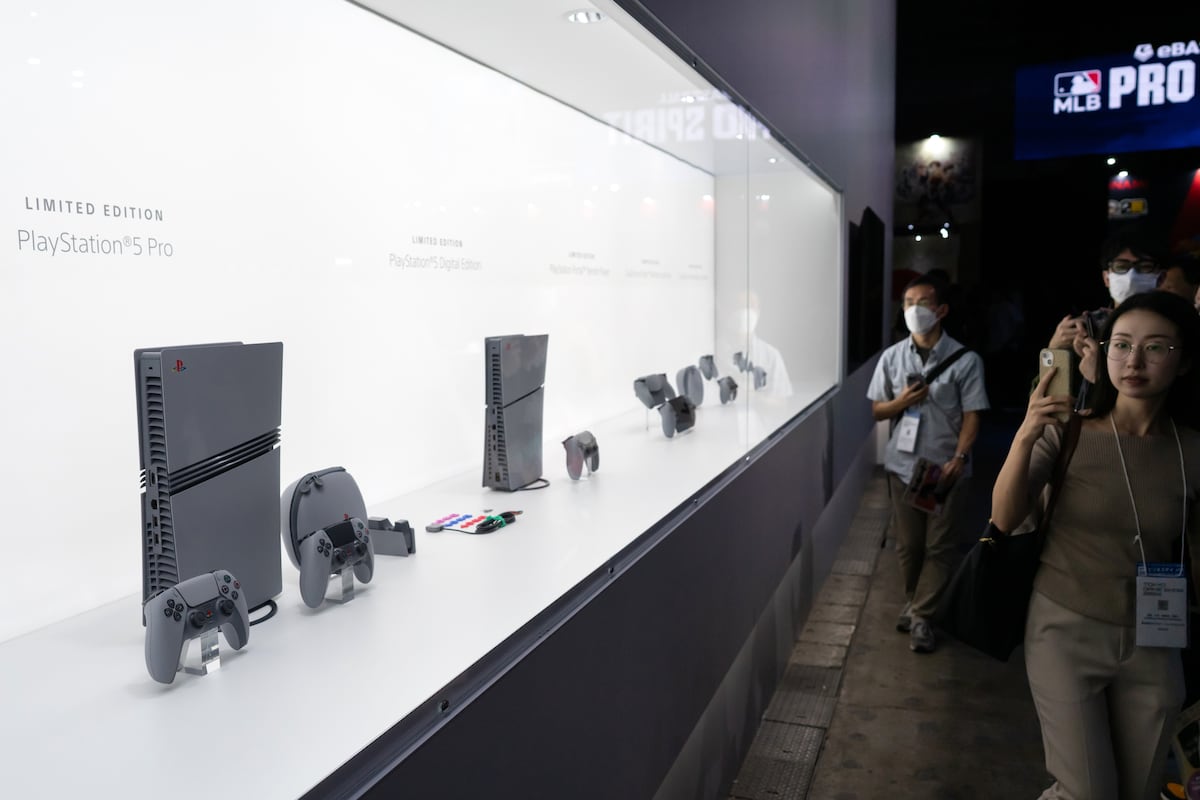Born as a result of a disagreement between Nintendo and Sony, two great rivals today who until that episode were working together to create a new device that would revolutionize the video game market, few could imagine in 1994 the impact that console would have. Sony’s PlayStation 1 will celebrate the 30th anniversary of its first launch on December 3. In addition to a special commemorative limited edition of 12,300 PlayStation 5 units, which were sold out months before the date, the anniversary also leaves a business lesson.
The different versions of PlayStation are already one of the most coveted and exchanged products on second-hand markets. In the case of the Milanuncios platform, it is the third most searched productonly surpassed in 2023 by sofas and bicycles. However, its demand has a very seasonal component. According to data from Wallapop, appetite increases between November and Three Kings’ Day. In 2023, within Wallapop there was a 64% increase in sales and searches for PlayStations in December compared to September levels. This year there was no need to wait for Christmas. The thirtieth anniversary has had a notable effect in increasing interest in it.
“We have detected an average increase of 30% in searches for the different models since the 30th anniversary presentation and the launch of the special limited edition. That is almost a third more demand,” says Íñigo Vallejo, spokesperson for Milanuncios. Functioning as a kind of reminder that the console is there, both demand and supply have been activated. On the former side, searches for PlayStation 5 have increased by 42% since the announcement; those of PlayStation 3, 11%, and those of PlayStation 1, 9%. In the offer, PlayStation 3 ads have risen 23%; those of PlayStation 5, 20%, and those of the original console, 19%.
Asked why he thinks this has happened, Vallejo does not hesitate to point out a usual suspect: nostalgia. “It never ceases to surprise me. We have seen it with many other issues, but with the PlayStation it is being especially noticeable,” he comments.
Why play something old?
Go out for a walk. Read a book. Watch a series or a movie. Go out to dinner. Doing sports… Among all the leisure options available, and with within each of them almost de facto infinite options given the often wide catalog and limited time, there are people who also choose to play video games from many years ago. . Elu Tortosa is one of those players, a collector and the president of the Barcelona association of classic video game lovers Retromaniacs.
Tortosa says that they call it digital nostalgia. “They had a great time playing in their childhood and they revisit that phase through video games. There are people who do it with music, for example, but we must also add that there are video games that were authentic works of art,” he recalls.
Although, according to Tortosa, it is still early to consider the PlayStation 1 a collector’s item, like the Nintendo Entertainment System or the NeoGeo, “both the PlayStation 1 machines and their games are not highly valued because there are many of them and they are relatively recent”; It does detect that there is beginning to be greater interest in it. “With its anniversary, those who played it as children have remembered that they are excited to have it,” he says.
Beyond the feelings that it evokes in players like Tortosa, putting hours into something that they already liked when they were younger, the president of Retromaniacs also talks about how the gaming industry has changed since then. Now, although better graphics make games like interactive movies, it detects lower difficulty, higher prices and attacks monetization models, such as, for example, abusing charging for downloadable content or payments to access features extras. “Before, the game was yours and they sold it to you complete,” he remembers.
Whether because the new thing is not convincing or because the emotional bond is powerful, the fact is that the formula of nostalgia in video games works, a lot. Not only does the industry release new installments of franchises or promote reissues of those that were most successful, as has recently happened with Resident Evil 4, but it also takes advantage of the pull to take the sagas to new platforms and business models.
On October 17, Microsoft and Level Infinite launched Age of Empires Mobile, the smartphone version of the legendary strategy franchise. Available to download for free, includes the option of in-game payments. In less than two weeks it has achieved more than one million downloads and 134,000 reviews. Although it has an average score of 4.1 stars out of 5, not everyone has been happypointing out that nostalgia is a powerful weapon, but a double-edged one due to the risk that the most unconditional lovers will feel disappointed.
This is what has happened with another legendary franchise: PC Fútbol. The Una Partida Más studio has been working on the eighth installment years after the last one. With at least 13 delays behind them, fans of the saga were outraged by the game’s failure to arrive on time and by the content that was leaked in its presentations.
“Nostalgia cannot be the only tool,” reflects José María Moreno, general director of the Spanish Video Game Association. “Behind the nostalgia there has to be good products. Many times, when an old brand is rescued, good products are made, but in this specific case it does not seem to have been like that. Appealing to nostalgia is not enough. There has to be a product that was good in its day and that today its modern version is also good,” he says about this emotion, which for Moreno is not only a commercial engine, but an element that contributes to the cultural legacy that leave this industry.
Pablo de la Nuez is the CEO of Raiser Games, a games division of Webedia. With 27 years of experience in the sector, he was part of the team at the now defunct FX. The Spanish company was behind such renowned games years ago such as TZar, Sacred or Patrician III. “They even currently contact me to tell me that they continue playing TZar every week,” he reveals.
In his reflection on nostalgia, De la Nuez concludes that each generation has its own. “Before, games were very based on the discovery that the player made. There was hardly any information. Now we see a generation that seeks to discover everything quickly and generate intense emotions immediately. The new generations also have nostalgia, but in their own way. They have it because of the games that marked their childhoods, because there are games that stay in their memory,” he adds.
To the unanimously stated reason of wanting to relive old memories, the veteran expert in this industry adds more reasons to justify the players’ longing. “More than the fact that games like those are no longer made, perhaps it is also a question of comfort space. You go to a game because you like it the way it is. There were also games that were so vast that it’s like they were worlds unto themselves. For example, the TZar or the Patrician III, you could get in there and never get out,” he says.
Although the PlayStation 1 does not yet occupy the central places on collectors’ shelves, everything indicates that thanks to its anniversary it is occupying the memories of a generation that decades ago began to hold its controllers for the first time.
With a video game industry in Spain that, as Moreno describes, is going through a good moment, there is optimism about the ability to continue offering entertainment to more and more people. The sector has seen double-digit growth in recent years, with nearly 1.4 billion euros in turnover in 2023 and more than 20 million players, of which 49% are women, a higher percentage than in the rest of Europe. . “It is foreseeable that the sector will continue to rise, especially in the field of Mobile. Last year’s growth was largely due to this segment and the availability of next-generation consoles,” analyzes the general director of Aevi.
The trend is positive, but only time will dictate which games, consoles and studios will leave a mark in history and in the hearts of their players deep enough to make them want to return to them again and again.
The state of the video game industry in Spain
Lights
As Moreno, the general director of Aevi, recapitulated, the sector has been experiencing a boom in our country for years. Several Spanish studios, specifically MercurySteam, the firm behind the historic and renowned Castlevania saga, and Tequila Works, which rose to fame with the game Deadlight, attracted the attention of large foreign companies that acquired them. Moreno says that sagas like Assassin’s Creed or superhits like Candy Crush have passed through the hands of developers based in Spain.
Shadows
Precisely, one of those lights, the fact that there have been studies powerful enough to attract international buyers, draws what is the great shadow of the industry. In Spain there are, according to the Aevi census, 877 registered studies. Most have between two and five employees and the few large ones that exist ultimately belong to foreign firms. Pablo de la Nuez regrets this lack of Spanish business structure, given that the sector is incapable of giving birth to a national champion in the style of Paradox in Sweden or CD Projekt Red in Poland. Without that champion and without that business structure behind them, studios disappear more frequently.


